Nevada is one of the most geologically diverse states in the union. The deserts constantly yield an incredible amount of stones and gemstones, and the diversity is hard to match anywhere else in the United States. Like much of the southwest, there are various gems, minerals, and rocks scattered all over the place.
So, let’s get into it with a list of Nevada’s rocks, minerals, and gemstones!
Minerals and Gemstones of Nevada
1. Gold
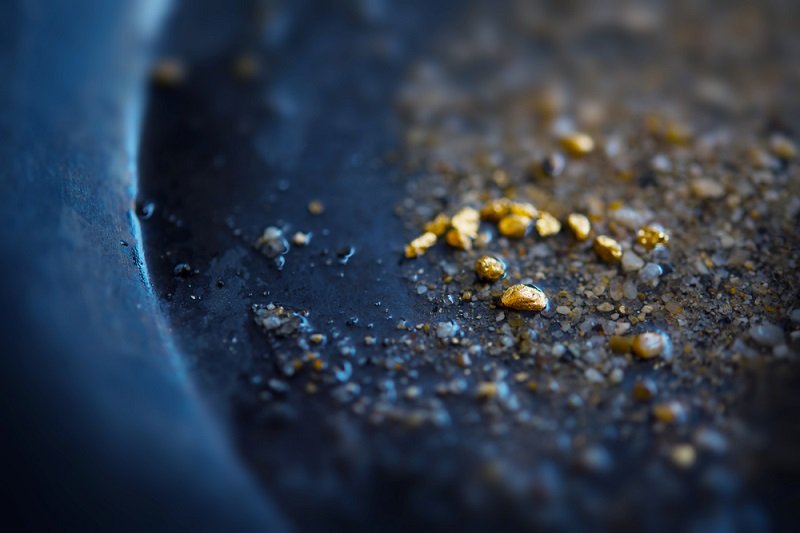
Gold is the yellow stuff that made the world run for much of human history. It’s one of the least reactive metals, making it easy to find in nature since it’s rarely trapped in another chemical form. Gold is usually found in its elemental form, a bright yellow metal with a ton of shine. It’s still quite valuable, even if it’s not the basis of currency anymore.
The entire American West experienced a series of gold rushes and Nevada is no exception. Currently, Nevada produces more than 3/4ths of the gold found in the US each year and about 5% of the world’s global output. It also contains the largest gold mine in the country.
Those who are seeking gold as hobbyists will need to find the right areas to search. Metal detectors are preferred in this environment due to the dry climate, but there are some places to pan for gold as well. There is one thing to be aware of: much of Nevada’s gold is contaminated with silver, creating the alloy electrum. Don’t chuck any bits of metal you find until you’re 100% sure, as electrum can be silver or dull gold colored depending on the contents.
Some of the places that prospectors have had luck are the following:
- Pershing County
- Willow Creek
- Humboldt District
Gold isn’t a guarantee, but your chances in Nevada beat those of most states!
2. Obsidian
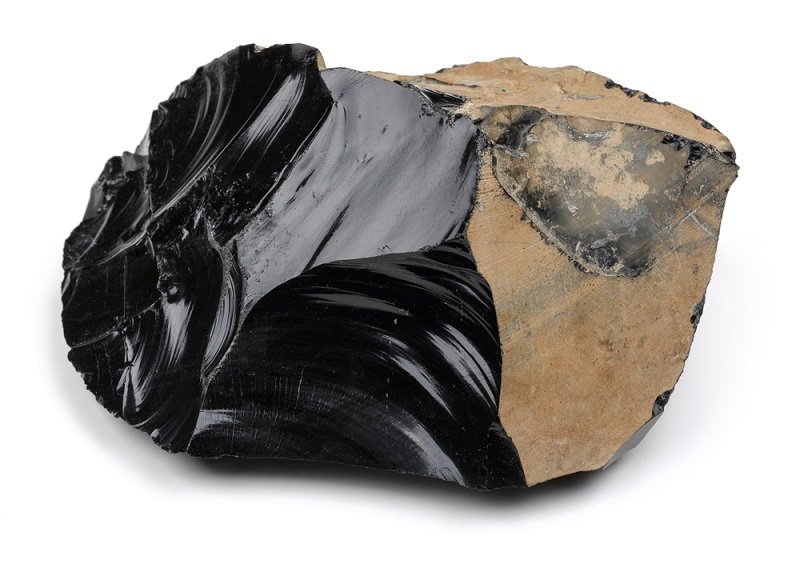
Obsidian is a silica-rich magma product, and not technically a mineral. You see, obsidian lacks the internal structure that defines minerals. Instead, obsidian is an amorphous form of silica. A glass, in other words. Obsidian is known for its deep black color and its use in artifacts across the Americas.
Obsidian comes in many forms. The most common is simply shiny and black, colored internally by iron particles held in suspension. Others include the magnetite-included rainbow obsidian, snowflake obsidian with its cristobalite formations, and strange forms like the aerodynamic Apache Tears.
Obsidian is found in several places across the state of Nevada, with a few different varieties present. It doesn’t quite match the diversity of the southern Mojave in California and Arizona but it does come close. It’s mostly found along the southern portion of the 95, near the California border. Make sure to check permission before heading out to a spot blindly, there are all kinds of “fun” things to run into out there… like artillery ranges.
The following areas are all known to house a good amount of obsidian:
- White Rock Canyon
- Nye County
- Obsidian Butte
Your best bet is to talk to local collectors or rock clubs, they’ll know where to find it and how to avoid running into problems.
3. Amethyst

Amethyst is a purple variety of quartz, the macrocrystalline form of silica found most often. It’s colored by ions dispersed in the color centers of the crystal, creating unique purple stones that are a favorite among collectors. Before the discovery of massive deposits in South America it was an incredibly expensive stone as well, considered equal to ruby, sapphire, and emerald.
While the precious nature of the gemstone isn’t at the same level these days, the stone remains a fast favorite. Amethyst is often graded by color, deeper saturation is preferred. Amethyst has a secondary color to its flash. This is usually red or blue, and the price varies based on this as well. For specimen collectors, it’s great because large samples can be found without breaking the bank.
The amethyst of Nevada isn’t all that remarkable, but the best piece is always the one you dug yourself. Here it tends to be found as points and clusters, often hidden just underneath the surface of the Earth. Occasionally smaller samples of ametrine also appear where amethyst is found, the bi-colored stone having much greater value than either amethyst or citrine alone.
If you’re out for the purple quartz, then check the following locations;
- Comstock Mining District
- Petersen Mountain
- Erickson Canyon
That’s only a start, there are about 25 known locations in the state, and there are sure to be more not yet revealed.
4. Turquoise
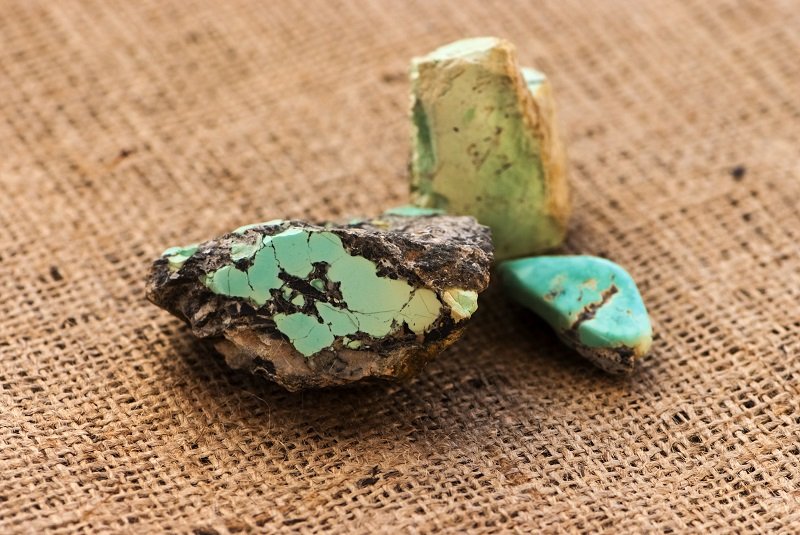
Turquoise is a prized gemstone, often used in Southwestern-style jewelry. Its presence across the Southwest is well known and some of the mines here have produced incredible varieties over the years. The sad truth is that most of the public claims are mined out these days, but there are sure to be more that have yet to be found.
Turquoise is colored by copper and is often found alongside other secondary copper minerals like chrysocolla. Due to its value most of the better places to look have already been staked out. If you’re okay with stabilizing material then you can still find some suitable. The chalky, lower-grade turquoise can be made workable with a bit of resin, acetone, and ingenuity. It’s standard practice, just disclose it if you decide to sell the piece.
Turquoise’s value makes it hard to find good places to find it. Most of the listed locations have been heavily mined out but you may still get lucky. Searching the area around known locations can also yield decent amounts. Another good place is copper mine tailings, where bits of the material can accumulate after being dredged from the earth.
The following locations should give you a good start:
- Ackerman Canyon
- Iowa Canyon
- Near Battle Mountain
You may not find the mother lode, but these places are a good spot to start your search.
5. Garnet
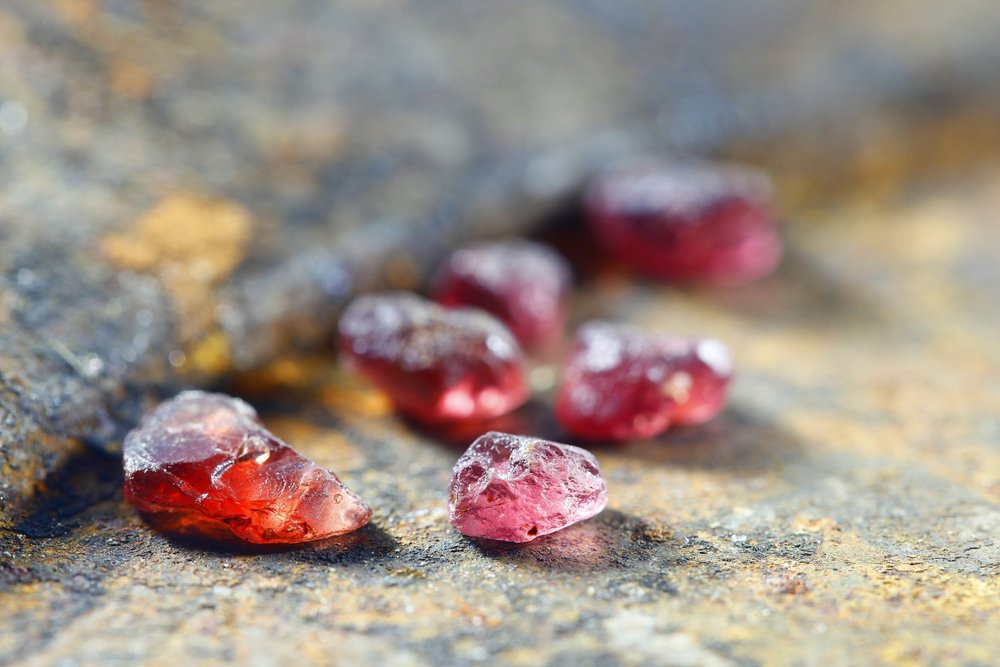
Garnet is a family, rather than a single gemstone, but they’re most known for red gemstones and opaque twelve-sided crystals. Well-formed garnet crystals are incredible specimens, among the few crystals that I personally seek out without the intention to cut.
There’s a huge range of colors in the garnet family. They range from pale yellow to deep crimson to shocking shades of green depending on the variety and location. The garnets in Nevada are red for the most part, with some edging towards orange-ish.
Fortunately for collectors, they’re also easily found. The location of Garnet Hill has an area set aside for rockhounds to dig to their heart’s desire. They’re found in hard rock outcroppings. The host rock here is rhyolite, a fine-grained igneous stone with decent hardness. Just make sure to bring a rock pick.
You’ll also need your own water and food if you head out to Garnet Hill since neither is available at the site itself. Bring water, the desert is not forgiving to those who are unprepared.
6. Variscite
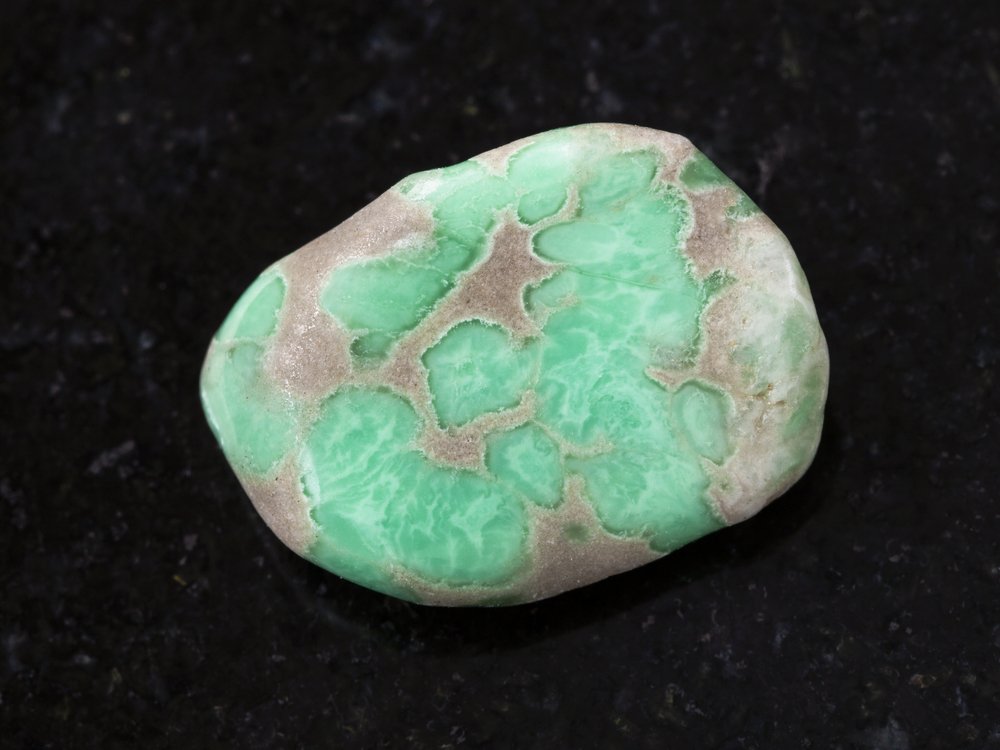
Imagine turquoise… but green. That’s what the gem-quality version of variscite resembles and it’s highly sought after for that reason. Variscite is incredibly rare and Nevada is one of the few places where it can be found. It appears as both green crystals on other rocks and green splotches hidden among other stones.
Variscite is similar in composition to turquoise but its coloration actually comes from chromium rather than copper. Chromium is known for producing intense green in many stones, it’s the coloring agent in some emeralds for instance. The rarity of variscite keeps the value high, a good quality find can make you some serious money.
Variscite, like many precious gemstones, can be hard to pin down. If a location is listed online then chances are it’s been gone over heavily in the past, but there’s always a chance to find something new. Those of us who go through the same areas repeatedly can assure you that rocks have a mind of their own and changes are frequent.
The following locations are known to host variscite:
- Esmerelda County
- Lander County
- Humboldt County
A bit of study of these regions should yield at least a few pieces for your collection.
7. Opal
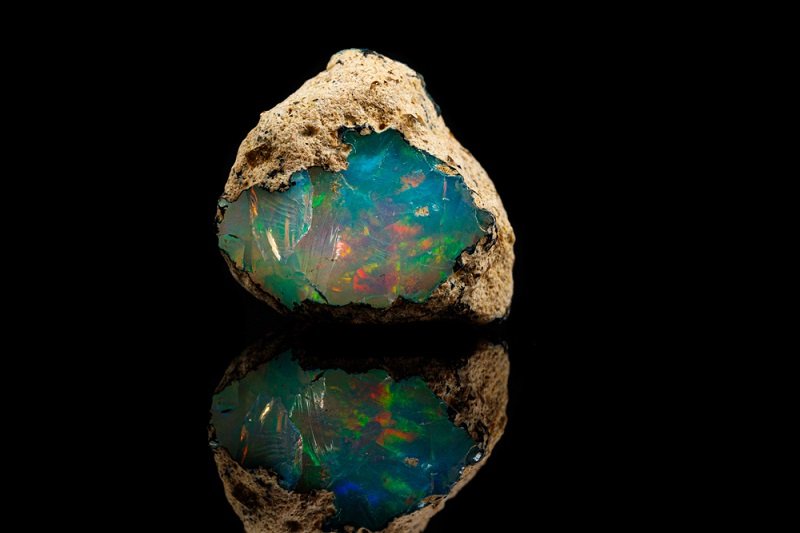
Opal, specifically black precious opal, is the state gemstone of Nevada. Opal itself is an amorphous form of silica, not a glass but instead comprised of densely packed silica spheres. These spheres can scatter light, which is the differentiation between precious and common opal. The internal fire of these gemstones is hard to beat.
In Nevada, we have a rarer variety than “simple” precious opal. Black opal is primarily known in Australian locations, but it emerges from mines in Nevada as well. The dark background of the stone makes the internal play of color even more intense and the stones tend to be very high quality.
Of course, all known sources of this material are claimed due to the high value of the gemstone. That doesn’t mean you’re out of luck, however, many of the most famous mines also allow fee digging. This usually means going through the tailings of a mine, or perhaps a surface area, so you’ll be picking through spots for a second time. That doesn’t mean it’s a waste of time, however, as it’s easy to miss large pieces when extraction occurs.
I recommend checking out the Royal Peacock Opal Mine if you’d like a chance to mine your own. They produce the best opal in the state and sometimes open up very nice areas for their customers to search.
8. Beryl
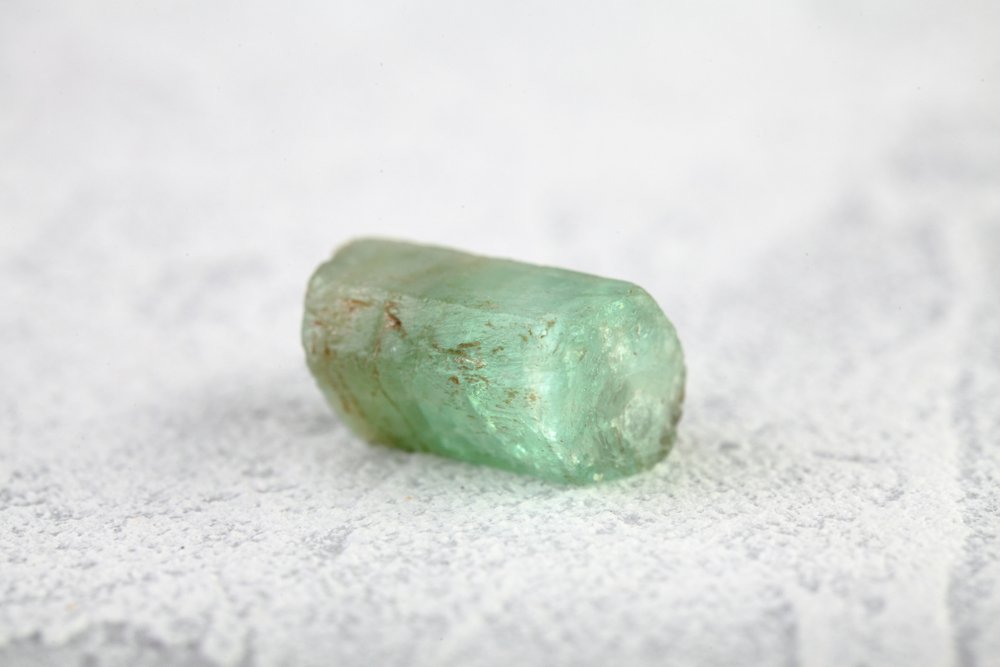
Beryl is the gemstone family that hosts such favorites as emerald, bixbite, and morganite. Beryl crystals are more common than you’d think, but the majority of them aren’t gem quality. Beryl has an octagonal crystal form which makes it easy to recognize in the field, especially since it’s harder than the majority of stones as well.
Beryl is often found in pegmatites. These are conglomerates of stone that have larger grains than normal, often being comprised of large pieces. They’re relatively easy to pick through since you can break off a piece, examine it, and dig out anything you want to keep as long as you have the right tools. Pegmatites often host a wide variety of crystals, you’ll usually find more than just beryl.
While the beryl here is rarely gem-grade, it does come in a wide variety of different colors. Some of them are even quite saturated, it’s clarity that’s lacking in these specimens. Light blue appears to be the most common color but light pink and light green are also common finds depending on the region.
The best place to search for beryl is the southern portion of the Ruby Mountains. The Sylvania District in Esmerelda County is also considered a prime spot to find colored beryl for the intrepid rockhound.
9. Azurite
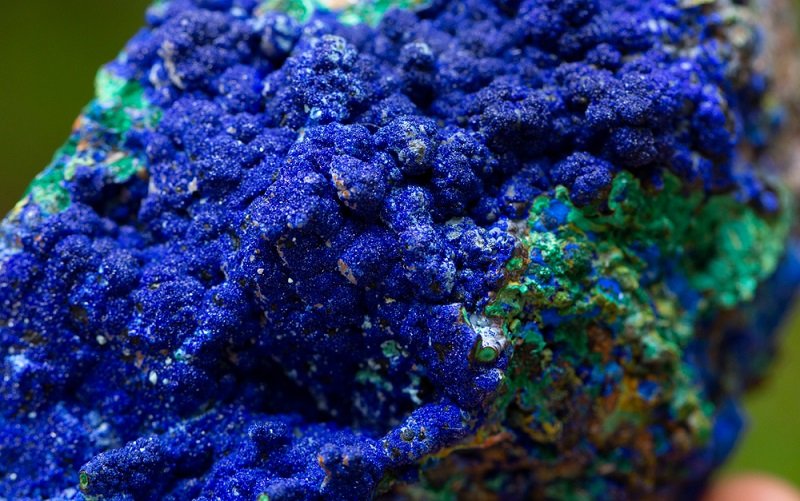
Azurite is a copper mineral with a deep blue color. It’s been used as a pigment for a long time, producing blue paint that was easy to mix for different shades. It was generally cheaper for this use than lapis lazuli and doesn’t result in the same ultramarine color. Its found in a crystalline form, which is brittle and rather soft at a 4.0 on the Moh’s scale. For this reason, it is very rarely used in jewelry.
Azurite is often mixed with malachite. On exposure to air, azurite will begin to turn green, slowly degrading into malachite. This effect can even be seen in old paintings where oxygen has managed to enter the pain, slowly turning the blues into greens. This is a very slow process, and azurite is generally considered “shelf stable” by experts.
The cool part is that Nevada has a ton of this stuff. Its association with copper mines and the large amount of them in Nevada have proven to be a boon for collectors. Azurite has many forms, from encrusting bedrock to small crystals to rough-grained blue rocks. It’s one of my favorites for collecting and it’s relatively easy to dig it yourself if you’re in Nevada.
The following places are good spots to check:
- Churchill County
- Clark County
- Pershing County
You’re specifically looking for places associated with copper mines and turquoise deposits, both of which often have azurite nearby. Be careful around old mines. The desert is dangerous enough even when you don’t have to keep an eye out for old mine shafts.
- Online rock and mineral club for collectors of all levels!
- Find community with like-minded rock and mineral enthusiasts.
- Monthly Giveaways!
- Free Access to Entire Digital Library of Products (current and future products)*


